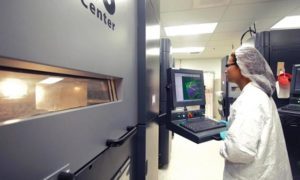The advent of 3D printing has sparked a huge interest in healthcare, and its potential is being fully explored by people like Cynthia Star, director, technology transfer with Johnson & Johnson, 3D Printing Center for Excellence. She works closely with several J&J business divisions and outside partners to make the most of what the tech has to offer.
“Our team acts as an ‘innovation hub’ within Johnson & Johnson, cultivating a strong pipeline by incorporating 3D printing technologies across… [J&J’s] businesses,” Star said in an interview with MD&DI. “We collaborate daily with R&D, marketing, and supply chain to identify and drive 3D printing innovations and processes. We also look at ways to augment our work by partnering with the top minds around the world, as working alongside them allows us to remain on the cutting edge of 3D printing and new technologies.”
In 1983, a man named Chuck Hall built the world’s first 3D printer and successfully printed the first object – a small eye wash cup. Despite the rather everyday-nature of the little black container, it started a quiet revolution that has led to significant changes in healthcare. 3D printing is a type of additive manufacturing process that builds a three-dimensional object by laying down successive layers from a raw material until it is complete. These items are created from a digital 3D file – such as computer-aided drawing (CAD) or an MRI.
Star sees almost infinite uses for 3D printing in medicine – ranging from the personalized prosthesis to customized pharmaceuticals, bioprinting, and tissue reengineering. She thinks that the printing technology can also aid with manufacturing products that were impossible to make using traditional methods – potentially allowing for faster, more efficient, and sustainable delivery of needed items, even in remote locations.
"Our group believes that 3D printing can help us re-imagine innovation to deliver better health for humanity because we can potentially serve patients globally with more personalization, speed, and efficiency. With 3D printing, design freedom increases our ability to customize, providing us with the potential to address significant unmet patient needs in ways that were not possible before. It can help improve access to healthcare products and solutions, along with [achieving] greater efficiencies in terms of production, assembly, and supply chain."
Avi Reichantal, founder and CEO of product development company XponentialWorks, wrote about a client named Amanda Boxtel, who needed a very specific prosthetic solution. She was paralyzed from the waist down after a skiing accident shattered 4 of her vertebrae 26 years ago. A bionic exoskeleton suit gave Boxtel the gift of mobility, but it was 3D printing that "gave her the symmetry and freedom of range of motion that, like all humans, crave." Reichantal was able to digitally capture Boxtel’s measurements and create a custom-made suit tailored to her unique needs, for example.
Star points that collaborating with both industry and academia is essential for staying abreast of advances in 3D printing technology. She emphasizes that it's the patient's voice that shapes how J&J implements 3D printing throughout its organization. Whether that is providing a cutting-edge 3D printing surface structure to stimulate faster bone ingrowth, minimizing the weight of a handheld instrument via topology optimization, or 3D printing molds for a manufacturing process pilot run.























